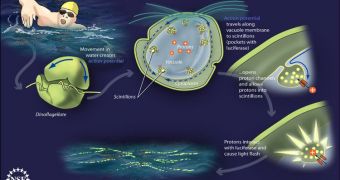In a study published in the October 17 issue of the esteemed journal Proceedings of the National Academy of Sciences (PNAS), researchers at the Emery School of Medicine and the Harvard University propose a new possible explanation for why bioluminesence develops in the world's oceans.
Sailors and others at sea recognize the phenomenon by the distinctive blue flashes that it produces on the surface of the water. In some areas of the world, the events can be seen clearly, and are naturally best visible at night.
Unicellular plankton known as dinoflagellates have been established to be the cause of these natural occurrences, but researchers until now had no idea as to what type of mechanism the microorganisms were using in order to produce the luminescence.
Emery School of Medicine researcher Susan Smith and Harvard expert Thomas DeCoursey were the leaders of the new investigation, which was only made possible by funds secured from the US National Science Foundation (NSF).
According to the research team, voltage-gated proton channels on the surface of the dinoflagellates are largely responsible for the natural flashes. These channels pass through cellular membranes, but can only be turned on or off by electrical and chemical events.
The fact that these channels exist in this form of plankton was first proposed as many as 40 years ago, by investigator J. Woodland Hastings. The expert was now a member of the research team, and is also listed as the author of the PNAS paper.
In order to confirm that the channels were real, Smith and DeCoursey had to analyze the genes of dinoflagellates, looking for information that would reveal the presence of the voltage-gated proton channels. Theoretically, they should have left behind markers like those found in humans and mice.
This is what the team did indeed discover. The team believes that the plankton produces bioluminesence because the movement of the water is sending electrical impulses through the vacuole, which is the internal compartment of the microorganisms.
As this happens, the abundance of protons within are being pushed into adjacent tiny pockets surrounding the vacuole, called scintillions. The protons move through the aforementioned voltage-sensitive proton channels while doing so.
But scintillions contain large amounts of luciferase, a protein that can be made to release flashes of light when bombarded with protons. The team is basically saying that the movement of the water itself is what powers up the bioluminesence.

 14 DAY TRIAL //
14 DAY TRIAL //